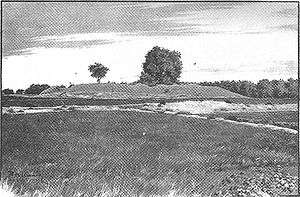Shaji-ki-Dheri

1899 engraving showing the remnants of the Kanishka Stupa in Shaji-ki-Dheri.
The inscribed Kanishka casket found at the site of the Kanishka Stupa and containing relics of the Buddha, now in Peshawar Museum, Pakistan, while the relics are in Mandalay, Burma.
Shaji-ki-Dheri is the site of an ancient Buddhist stupa, about 6 kilometers from Peshawar, Pakistan.[1]
American archaeologist David Brainard Spooner conducted excavations there in 1908-09 for the Archaeological Survey of India leading to the identification of the Kanishka stupa dated to the 2nd century CE, and the discovery of the Kanishka casket.[2] Spooner published a paper following the excavations: "Excavation at Shaji-ki-dheri: Annual Reports of the Archaeological Survey of India 1908–09".[3]
References
- ↑ The Grandeur of Gandhara: The Ancient Buddhist Civilization of the Swat, Peshawar, Kabul and Indus Valleys, Rafi U. Samad, Algora Publishing, 2011, p.146
- ↑ The Grandeur of Gandhara: The Ancient Buddhist Civilization of the Swat, Peshawar, Kabul and Indus Valleys, Rafi U. Samad, Algora Publishing, 2011, p.146
- ↑ The Cambridge World History: Volume 3, Early Cities in Comparative Perspective, 4000 BCE–1200 CE, Norman Yoffee, Cambridge University Press, 2015
This article is issued from Wikipedia - version of the 11/25/2016. The text is available under the Creative Commons Attribution/Share Alike but additional terms may apply for the media files.